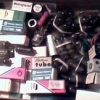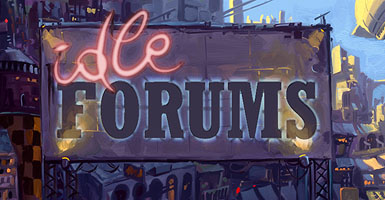-
Content count
135 -
Joined
-
Last visited
Content Type
Profiles
Forums
Calendar
Everything posted by shbazjinkens
-
IMO, breathing is still the kind of thing that should be optional in the game menus. I can understand how it would get some people more into the game, but I tend to be disconnected in most games anyway so it would just seem weird for me.
-
Rather unrefined, but #4 is done! Hearing the breathing all of the time would really get on my nerves, not intensify the atmosphere. I can deal with a little hard breathing after running or bursting out from underwater, but all the time? Nah.. I can hear my own breathing for that.
-
I use the term FPS too loosely I suppose. Many games called FPS have modes for 3rd person as well, but they're all shooters to me. I guess I should start calling them that instead. I wouldn't make a game just to stir up trouble, that would be a monumental waste of my time and name. I just think that would be an interesting result from it that could be taken advantage of. The concept alone is interesting to me. Of course I agree that the gameplay shouldn't suffer. Otherwise what I'm talking about would be little different than those sappy flash games that I'm sure you're familiar with, and would never cause any media stir. The games you mention (except for one) seem to only feature this as an optional side note. What I'm thinking of is a game totally featuring the people looked upon as thoughtless beasts by many Americans (Iraqi Terrorists, Al-Qaida, Palistineans) and put the gamer in their shoes, with your family members disappearing, innocent civilians on your side being killed, and you going to take revenge in the fashion that those terrorists have. The very concept of showing sympathy for terrorists is what I think would cause a huge stir, but only if it was actually well produced enough to attract enough people in the first place. I don't have the time or resources to actually go through with anything like this, just what I thought was an interesting thought.
-
Well, you're describing it from a programming perspective, whereis I just use it and look at it.. it's kind of like if you asked a mechanical engineer how a car works, in comparison with asking a 5 year old.
-
I'm going basically on what I've done and what I've read, but my arguments against water reflections are unfounded. I did some searching through the articles on this site, and one example (http://www.idlethumbs.net/screenshot.php?id=73&article=23) clearly shows that I'm wrong. EDIT Previously I've only seen stuff like this: http://www.idlethumbs.net/screenshot.php?id=79&article=23 which does not have a very good water surface. I think I should be browsing more game sites rather than just the game art forum I frequent (cgtalk.com) so that I'll see the work of more teams rather than individuals. I don't have an ounce of programming experience, of that you are correct. This is kind of what I'm hinting at.. with Raytracing a lot of this complicated stuff turns into pressing a button and adjusting a slider once it's programmed. Maybe scanline reflections are the same though, I don't know because I'm no programmer. I was under the impression that this kind of thing fell under sub-surface scattering or plain multi-layering. The fresnel function in Blender and Yafray will cause the reflection or refraction to show up less the higher it is turned up, and another slider causes slight distortions and modifies angular reflection. Fresnel, the man, invented the polarized lens which has nothing to do with multilayered textures or fading reflections, so maybe it's become a general term? My problem, you see, is that I haven't been spending enough time looking at game art, rather I've been trying to create it, focusing nearly entirely on characters and animation. Thanks for not getting too frustrated to type.
-
I didn't refer to it taking extra memory, but extra CPU usage. Taking an extra pass cuts your FPS in half, unless you have it selectively rendering only that small area that is a mirror. Doing this is also effectively the same as flipping the scene, except it is calculated in two passes instead of one (unless it selectively renders only the mirrored area). Self-reflection is also a nice thing to have IMO, but not necessary. Also, I wasn't claiming that Raytracing is faster, even a novice knows that, I think it is better than scanline, and I don't know how you can disagree with that. Specularity maps, you seem pretty knowledgable, so I'm sure you know what that is.. By making a spec map you can make liquid shiny and dull in certain portions to give the appearance that it has that uneven surface that water has. Best when animated. It works along with a normal map to give a better appearance. The downside is that it only reflects the lighting system to give the appearance that it is reflective to everything (because it is shinier than everything else), but it doesn't bend it or mirror other objects. You go on to explain what I'm talking about.. but it's still lacking mirroring. By that I mean both self-mirroring (for walls and such) and mirroring that goes with the bumpmaps and specmaps. I can think of ways around this, but it's always more of a hassle for the game makers than if you just had raytracing. I didn't describe it very well, but I know what it is. I also know that it makes my rendertime shoot up no matter what renderer I use.. though all of the ones I use are free, I'm sure at least one of them would have implemented a faster method if it was readily availabe. Whatever realtime method you're referring to is probably a far simplified version of it so that it wouldn't matter. Many more limitations to the good ways of faking it as well.
-
Wrong. Namely it's hard to emulate wet surfaces, mirrors, and refraction. The way to emulate mirroring in a scanline engine is to make a surface transparent and copy the entire environment behind it, so that it is literally a mirror (and consumes twice the CPU usage that the scene would have normally because the scene has a duplicate acting as its mirror). To my knowledge, the only refraction is accomplished by pinching (or the opposite of) a sector of the rendering in 2d. The wet/shiny surfaces are emulated by making them reflect more light (but they still don't mirror anything). All of these methods are inferior to real raytracing. The reason they can raytrace in realtime and most other raytracers can take many hours or days is that they only selectively raytrace with a combination of scanline and limit their raytracing light sources. Blender3d does this, actually, and if they refined it to make it faster we could put it in the Blender3d game engine. You'll notice that the mirrors they have in that video are perfect (they have no fresnel - the blending of a mirrored image with the object itself, like a shiny car). Fresnel consumes a lot of CPU usage, and therefore they can't do that. The realtime raytracers are still flawed in a way, but better than scanline alone.
-

I hate cell-shading. If you want a cartoon looking game, then do it 'properly'
shbazjinkens replied to jp-30's topic in Video Gaming
I've messed with cell shading a bit, and it's fairly easy to get totally wrong. The shapes of the 3d objects need to be sharper in some places than you would imagine them to be, in order to properly create the visual effects. I see no fault in cell shading as a concept, just game makers who have no previous mastery of it. I forgot to mention, a big part of the cartoon Futurama is rendered cellshading. The opening scene is nearly entirely 3D. The characters may even be 3d, I can promise you that it is possible to do, albeit maybe not in realtime.
